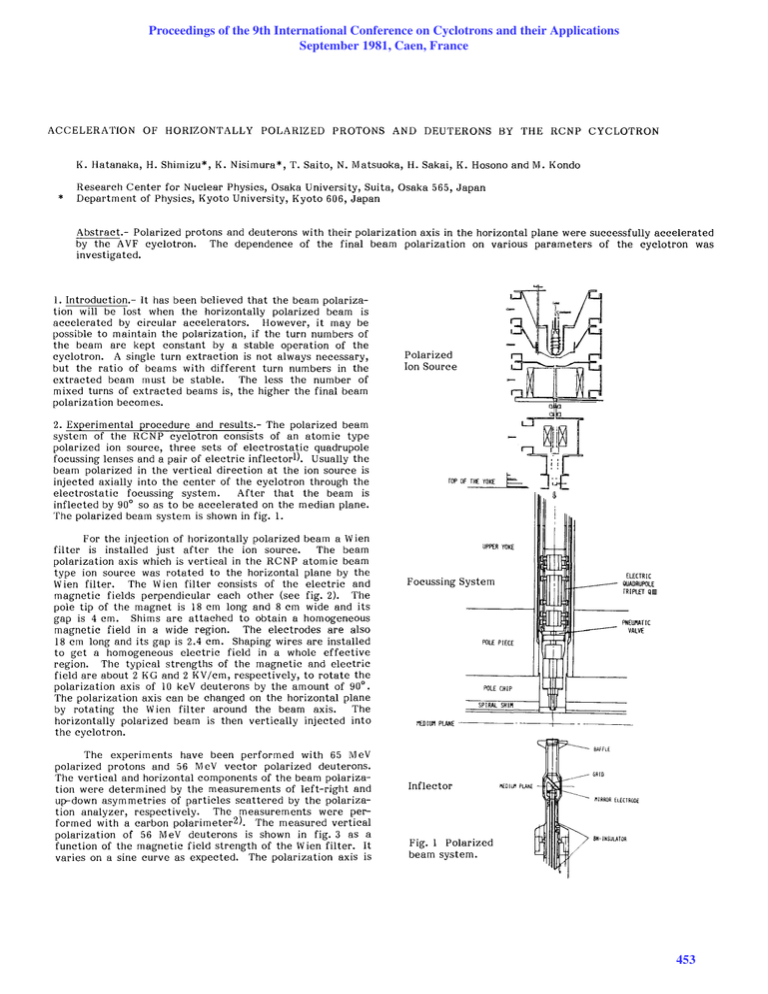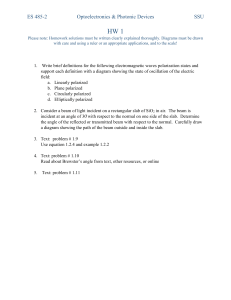EP-21
advertisement

Proceedings of the 9th International Conference on Cyclotrons and their Applications September 1981, Caen, France ACCELERATION OF HORIZONTALLY POLARIZED PROTONS AND DEUTERONS BY THE RCNP CYCLOTRON K. Hatanaka, H. Shimizu*, K. Nisimura*, T. Saito, N. Matsuoka, H. Sakai, K. Hosono and M. Kondo * Research Center for Nuclear Physics, Osaka University, Suita, Osaka 565, Japan Department of Physics, Kyoto University, Kyoto 606, Japan Abstract.- Polarized protons and deuterons with their polarization axis in the horizontal plane were successfully accelerated by the AVF cyclotron. The dependence of the final beam polarization on various parameters of the cyclotron was investigated. 1. Introduction.- It has been believed that the beam polarization will be lost when the horizontally polarized beam is accelerated by circular accelerators. However, it may be possible to maintain the polarization, if the turn numbers of the beam are kept constant by a stable operation of the cyclotron. A single turn extraction is not always necessary, but the ratio of beams with different turn numbers in the extracted beam must be stable. The less the number of mixed turns of extracted beams is, the higher the final beam polarization becomes. 2. Experimental procedure and results.- The polarized beam system of the RCNP cyclotron consists of an atomic type polarized ion source, three sets of electrostatic quadrupole focussing lenses and a pair of electric inflectorl). Usually the beam polarized in the vertical direction at the ion source is injected axially into the center of the cyclotron through the electrostatic focussing system. After that the beam is inflected by 90 0 so as to be accelerated on the median plane. The polarized beam system is shown in fig. 1. For the injection of horizontally polarized beam a Wien fil ter is installed just after the ion source. The beam polarization axis which is vertical in the RCNP atomic beam type ion source was rotated to the horizontal plane by the Wien filter. The Wien filter consists of the electric and magnetic fields perpendicular each other (see fig. 2). The pole tip of the magnet is 18 cm long and 8 cm wide and its gap is 4 cm. Shims are attached to obtain a homogeneous magnetic field in a wide region. The electrodes are also 18 cm long and its gap is 2.4 cm. Shaping wires are installed to get a homogeneous electric field in a whole effective region. The typical strengths of the magnetic and electric field are about 2 KG and 2 KV/cm, respectively, to rotate the 0 polarization axis of 10 keY deuterons by the amount of 90 • The polarization axis can be changed on the horizontal plane by rotating the Wien filter around the beam axis. The horizontally polarized beam is then vertically injected into the cyclotron. The experiments have been performed with 65 MeV polarized protons and 56 MeV vector polarized deuterons. The vertical and horizontal components of the beam polarization were determined by the measurements of left-right and up-down asym metries of particles scattered by the polarization analyzer, respectively. The measurements were performed with a carbon polarimeter 2). The measured vertical polarization of 56 MeV deuterons is shown in fig. 3 as a function of the magnetic field strength of the Wien filter. It varies on a sine curve as expected. The polarization axis is Polarized Ion Source TOP OF THE YOKE ~ i, UPPER YOKE Focussing System POLE PIECE [~rn MEDIUM PLINE PNE UMTiC VA LVE ~,;:: 'r POLE CHIP SPIRAL SHIM ELECTRIC DRUPOLE PlET QW r--- ~~ , I - BAFFLE GRID Inflector MEDIUM PLANE MIRROR ELECTRODE Fig. I Polarized beam system. BH-IHSULATOR 453 Proceedings of the 9th International Conference on Cyclotrons and their Applications September 1981, Caen, France 5 I c ~ 0 0.4 I- "0 ::J 0 >- r- III E E 3 o. jJ .-. T· . . - d - .-e-. r- « -0 .2 -.~. 0 " " ~ 0.5 N 0 a. " u E d =56MeV 27.5 o. V DEE ~ o a. +\ E E -0.5 >- o 2 1/1 B ( KG) - « I 12 C (p,p)12 C E p =65MeV • r- • o. t- I - • - III > I • •••• • I- ::J III I- t- I -::: / I 1 28.5 28.0 (arbitrary) I 0.5 "0 +.. .' \ Fig. 4. Up-down asymmetries of 56 MeV deuterons as a function of the Dee voltage. Open circles were measured using a phase-defining sli t. The li~es drawn through the experimental data are only for eye gUIde. c \ , ¢, ¢ 1 c I \ /- ~ Fig, 2. Cross sectional view of the Wien filter. 1: pole piece, 2: electrode, 3: coil, 4: yoke, 5: vacuum housing. Pv e-e---- \ >- 1/1 - \ 2- ~ - E d =56MeV I- I a. f-4 I I 12 C ( d, d) 12 C - • .-.-. I 1 2 3 - I Va II.y -1 ( arb i t r Q r y ) Fig. 3. Rotation of deuteron spin by the Wien filter. Solid line shows the curve of P v=0.72 x 0.433 x cos(B/BO Tr/2), where BO = 2 kG and 0.72 and 0.433 ilre beam polarization and the vector analyzing power of the 12C-polarimeter. fully rotated to the horizontal plane at the field strength of 2 KG. The field strengths were fixed at values which made the left-right asymmetry to be zero. The transmission efficiency of the Wien filter was above 90% for protons and about 40% for deuterons. The operation parameters of the cyclotron were varied to investigate the effects on the measured up-down asymmetries. Fig. 4 shows an example of the up-down asymmetries as a function of the Dee voltage. When the Dee voltage is changed, the turn numbers of the extracted beam is changed. The precession angle of the polarization axis is not same as the rotating angle of the beam owing to the anomalous magnetic moment. Angle difference between the polarization axes of deuterons with nand n+ 1 turns in the cyclotron is about 50°. Therefore, the period of the oscillation of the up-down asymmetries in the Dee voltage dependence should correspond to seven turns. Actually a periodical variation of up-down asymmetry with the Dee voltage was observed, however the relations between up-down asymmetry and turn numbers are not yet simply revealed. Measurerrents were also perfomed using a phase-defining slit 3 ) (open circles in fig. 4). This result is reasonable, because the phase slit 454 Fig. 5. Up-down asymmetries of 65 MeV protons as a function of the current of the no. 1 valley coil which is located at the center region. restricts the extracted beams to have small numbers of mixed turns, though the beam intensity was reduced to one third with the slit. The larger asymmetries were obtained as demonstrated in fig. 4. It can be seen from fig. 4 that the maximum horizontal component of the beam polarization was about 50% of the ideal value, 2/3. The beam polarization of the ordinary vector polarized deuterons was about 70% of the ideal value at that time. Consequently, the horizontal polarization was found to be more than 70% of the initial value at the ion source. If we assume the polarized ions from polarized ion source are injected into the cyclotron with the polarization axis perfectly rotated to the horizontal direction, this value can be achieved when the extracted beam is equally weigh.ted for three adjacent turn numbers in the cyclotron. Dependence of beam polarization on trim-coil and valley-coil currents were also investigated. Fig. 5 shows the up-down asymmetries as a function of the current of the no. 1 valley coil 4 ). From these measurements it was found that the horizontal beam polarization was not so sensitive to the conditions at the central region of the cyclotron, but was mainly determined by the turn number of the beam in the cyclotron. Proceedings of the 9th International Conference on Cyclotrons and their Applications September 1981, Caen, France Recently a test experiment has been performed to measure the tensor analyzing power Axz for the elastic scattering of 56 MeV deuterons from 4He. A preliminary analysis shows that the horizontal polarization has been very stable for more than eight hours. The horizontally polarized beam will be available for experimental studies in our cyclotron energy region. References 1) K. Imai et al., RCNP Annual Report (1976) p.23. H. Ejiri, RCNP Annucl Report (1976) p.29. 2) K. Hatanaka et al., RCNP Annual Report (1978) p.220. 3) T. Saito et al., RCNP Annual Report (1976) p.18. 4) M. Inoue et al., RCNP Annual Report (1976) p.6. 455



